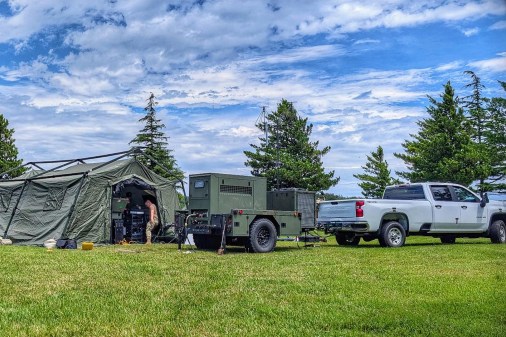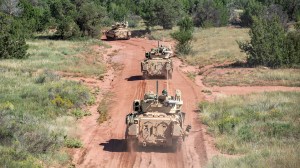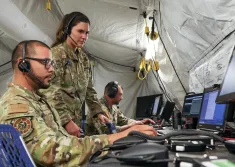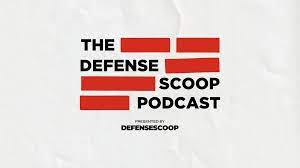Army wants ‘self-organized’ industry teams for Next-Gen C2 effort

The Army is looking for a team-of-teams approach for vendors to self-organize on its critical Next Generation Command and Control effort.
An entirely new way of doing business, officials have noted that Next Gen C2 will be a clean-slate approach rather than continuing to either bolt on or work within the confines of existing systems and processes. NGC2 aims to provide commanders and units a new approach to information, data and command and control through agile and software-based architectures.
Army Futures Command over the last year has been running experimentation to demonstrate a capability for NGC2 while, in tandem, the program office and Army Contracting Command have been working on the acquisition and contracting strategy for the eventual program of record.
As the program moves from prototype to a program of record and awards, the Army wants teams of companies to “self-organize.”
“We’re working with the best tech companies in the world, American companies, that are absolutely positioned to deliver capability to the U.S. Army, both large and small companies. By encouraging them to self-organize and solve the problem for us, to enable them to team with each other instead of us telling them how to do business, we’re largely getting government bureaucracy out of the way and unleashing the talents that already exist in our commercial enterprise within the United States to help us solve this challenge,” Joseph Welch, deputy to the commander of Futures Command, told reporters at the Pentagon Monday.
As part of that initiative, the Army has taken a somewhat hands-off approach to requirements. The service has sought to release a characteristics-of-needs statement — a living document that’s expected to be updated every 90 days or so — that is more descriptive of a problem for industry to solve rather than prescriptive requirements to build around.
The Army is looking for more teams to contribute to the NGC2 effort, with each of them bringing their own unique capabilities rather than relying on a single vendor to do the integration. Previously, according to officials, the single integrator wasn’t always effective because those companies might not have excelled at everything.
“We like to use the analogy Lego blocks. Everyone brings something, because normally we ask a vendor, ‘hey, do all of this,’ even though they’re not good at all of it. They might not be good at any of it, but they’re good at the process,” said Alex Miller, chief technology officer for the chief of staff. “Having the teams in place means that they can actually self-organize and pick the right components.”
The Army is envisioning continual competition with teams of vendors, with the ability to add vendors, remove vendors and ensure the best technologies can be brought in.
“I think there’s an opportunity here where we can have continual competition to make sure we’ve got best of breed across the capability and fundamentally underpinning that new approach on the open systems architecture. I think we can increase the opportunities for traditionals, non-traditionals, you name it,” said Lt. Gen. Robert Collins, military deputy in the office of the assistant secretary of the Army for acquisition, logistics and technology.
Officials maintained they want to be able to hold these vendors accountable throughout the process. Part of that — especially in an environment that is taking a completely clean-slate approach with a different requirements process and now a product owner-product manager perspective — is being a better customer.
“We’re moving away from this concept of an industry integrator into more of a team of teams. But on our side, we need to be a better customer,” Welch said. “It’s not just handing industry a problem statement and then walking away, waiting for them to deliver it, and then maybe holding them accountable if they don’t. That partnership, I think, means that we need to understand where we have shared incentives and where we may have different incentives — and then acknowledging those directly and understanding how to work through that.”
Welch noted the Army is looking at potentially different buying and consumption models, for example, where it pays for services as it uses them or as users continue to iterate on them.
“These are models that may be a little more complex to implement, but would better align our incentives compared to some of the ways we’ve done business with industry in the past,” he said.
The Army also is shifting away from paper demonstrations to forcing companies to actually test their solutions and offerings in live demonstrations.
Officials told reporters that contracts for NGC2 are “imminent,” without elaborating on a timetable. The anticipated timeline given in the past was May for contract awards for the program of record following the proof of principle demonstration of the capability at Project Convergence Capstone 5 in March.
It will be a call to industry following on the lessons from Project Convergence, the officials explained.
In parallel, the prototype with Army Futures Command will continue to iterate as well, allowing the service to learn lessons through additional experimentation. After Project Convergence, the Army will begin outfitting an entire division with the architecture with the plan to test it on the ground at Project Convergence Capstone 6 with the entirety of 4th Infantry Division, to include all enabler units.
Fielding for NGC2 also won’t look the same as the process has for capabilities in the past. While it takes a while to field the entire Army a new system, the cloud-based nature of NGC2 will enable greater access once live.
“I’m confident that when the first division gets the core software and data pieces of this, because they’ll be cloud-based, multiple divisions will be able to log in at the same time and start de-conflicting. It will not just be a vertical stovepipe deployment,” Miller said. “This year, the chief and the secretary have chartered us get a division and a corps squared away. As soon as that’s live, other units will be able to log in.”
Moreover, officials noted they don’t anticipate NGC2 costing any more than what the service currently spends on network and command-and-control systems.
“I said deliberately, we were going to do this in our budget, because there’s no room for things that won’t win. The chief’s been very vocal, as he’s talked about different systems, that some of our systems are actually older than most of us, which that’s not war-winning anymore,” Miller said. “Being able to stop and adjust and use the money that taxpayers gave us more efficiently, that’s the name of the game. That’s how we’re going to pay for Next Gen C2.”






